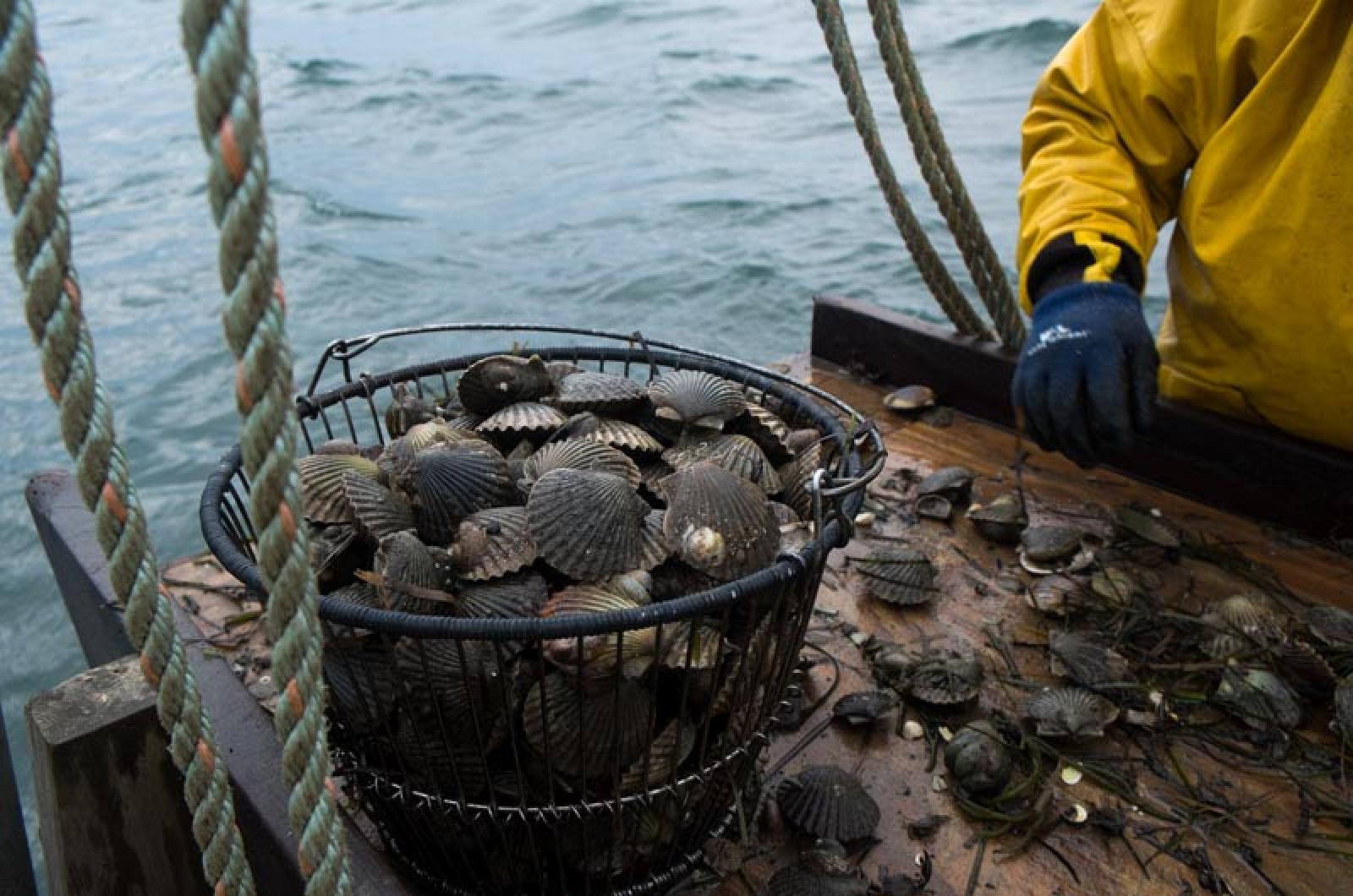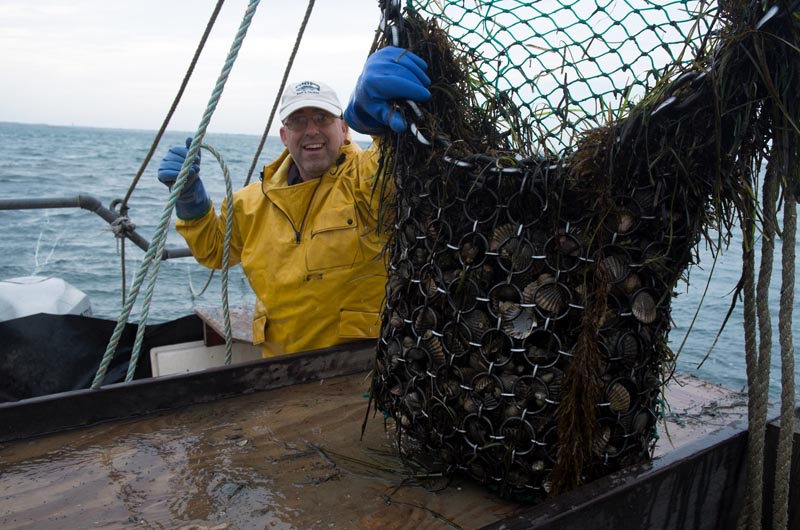At around 6 a.m. Wednesday, Cooper Gilkes and his son Daniel were in their kitchen in Edgartown wearing orange and yellow waders, drinking coffee and getting ready for another morning on the water. The longtime fishermen have been enjoying an especially strong start to the commercial bay scalloping season in Edgartown, which began Oct. 27.
Cape Pogue was the destination Wednesday morning. After motoring out of the harbor and into Cape Pogue Bay, Daniel cut the engine and Cooper began throwing the heavy dredges into the water, four on each side of the 25-foot Parker boat, which floated quietly down current.
The motor started up again and after a few minutes of dredging the bay floor, Cooper smiled. “Clean fishing,” he said. “I can tell by the way the drags are rattling.” The first dredges came up filled to the brim with bay scallops. Daniel hoisted them up with a rope and pulley and dumped them out onto the wooden culling board spanning the width of the boat.
On deck, the scallops gently opened and snapped shut, showing their rows of tiny blue photosensors. The men got to work separating the adults and throwing back the younger ones and the empty shells, along with clumps of seaweed, crabs, starfish and the occasional flounder.
“This is unbelievable,” Cooper said of the bounty. “We didn’t expect it this year.” Scallops typically live for only two years, so the size of the population depends heavily on the number of spawning adults in the previous year. The Vineyard bay scallop harvest has declined over the decades, but extensive hatchery and nursery programs run by the Martha’s Vineyard Shellfish Group have helped keep the Island industry alive. Scalloping season runs from October to March, with variations from year to year and from town to town. The recreational season in Edgartown began Oct. 1. The commercial season in Vineyard Haven and Chilmark opened Nov. 3., and in Oak Bluffs on Oct. 27. West Tisbury does not have a scalloping season because it lacks the necessary habitat. And this year Aquinnah will not be having a season in order to replenish its stocks.
Typically the bulk of Island scallops come from Cape Pogue, a large, unpolluted embayment off Chappaquiddick that is rich with sea life. But last year’s scallop harvest was much smaller.
Cooper said the work of the Edgartown shellfish committee was at least partly to thank for the increased harvest this year. “They are doing an unbelievable job,” he said. “It’s not just scallops we’re talking about. We’re talking about oysters, we’re talking about clams, quahaugs . . . We are now replacing what we take out.”
The Martha’s Vineyard Shellfish Group provides seed (young scallops) for the Island’s bays and ponds. Warren Gaines, the assistant Edgartown shellfish constable, said fertilized scallop eggs are spread in the hundreds of millions in Cape Pogue. But only a tiny fraction of those survive to adulthood.
“This year we are seeing seed, so we expect to have some next year,” he said. “Maybe not as many as we’re having this year — it’s kind of an up-and-down thing, but that goes back through the ages.”
Sometimes the scalloping season will be cut short in areas where the adults are scarce, since dredging the sea floor disturbs the younger scallops. Tisbury shellfish constable Danielle Ewart closed a large portion of Lagoon Pond last year since many of the scallops did not have a growth ring indicating adulthood. “We saw some pretty decent results from that,” she said Tuesday.
On Tuesday afternoon, a group of about 10 scallopers was scattered throughout a portion of Lagoon Pond known as the west arm as seagulls flew overhead with scallops in their beaks.
Many recreational scallopers use peep-sights (boxes or buckets with windows that allow you to see to the bottom) and long-handled dip nets to gather the scallops. Lagoon Pond is an ideal habitat, Ms. Ewart said, since it is shallow enough to allow for wading and also to support eel grass, an aquatic plant that is a key component of the scallop’s habitat.
Eel grass has been disappearing due to pollution, and on the Vineyard today one of the major challenges facing bay scallops is nitrogen runoff from wastewater, which can cause excessive algae growth in ponds, preventing sunlight from reaching aquatic plants. When the algae dies, it creates a layer of black muck at the bottom of the pond presenting a further problem for scallops, which prefer sandy habitats.
Rick Karney, director of the Martha’s Vineyard Shellfish Group, said the biggest efforts to preserve the scallops have involved reducing nitrogen runoff. He said the amount of eel grass in Sengekontacket Pond has declined severely.
Other problems include increased predation and changing weather patterns.
“Starfish and crabs will do a lot of damage to shellfish beds,” Mr. Karney said, adding that with milder winters, green crabs have become more abundant on the Vineyard. Another problem with changing weather is that when the ponds do not freeze over in the winter, diving ducks can prey on scallops for a longer part of the year. Despite the challenges, Vineyard scallops have fared much better than those on Cape Cod, where there is no longer much of an industry. The industry is now limited to the Vineyard, Nantucket, and to some degree Long Island.
In the 1980s, scallops saw a widespread decline that Mr. Karney said was something of a mystery.
“Places like the Cape, that had not had a great commercial fishery, pretty much lost that fishery,” he said. “And on the Vineyard where fishing was fantastic, it dropped substantially. And we don’t really know what happened.” Some point to the milder winters, or to heavy metal pollution in the Midwest that drifted east as the result of regulations requiring taller smokestacks.
There is likely no way of knowing what percentage of the local scallops are wild and what percentage are managed. “But the stuff we’ll put out is not going to support the entire industry,” Mr. Karney said.
By about 9 a.m. on Wednesday, Cooper and Daniel had their limit — three bushels each — and the well-travelled boat was chugging back to Edgartown harbor. Later in the season it will likely be a different story, as the adult scallops become fewer and fewer and more time is needed to reach their limit. But for now, it was good fishing.









Comments (1)
Comments
Comment policy »